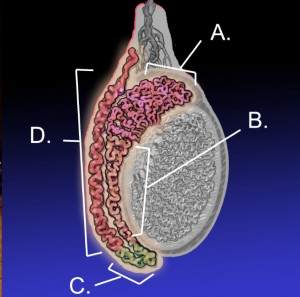The epididymis has been on my mind recently. The Epi-WHAT-amus? What is that? Well, for one, it’s probably the shortest 5-syllable word you’ve ever heard. And, it happens to be the name of an organ that can spell the difference between being a fertile or infertile guy.
Anatomy First

The epididymis is an 18-foot long, tightly coiled, almost microscopic, sperm-filled tubule that could fit into a pen cap. It sits on top of, and wraps behind, the testicle. Sperm pass from the testicle into the epididymis and, over about 12 days, get rubbed, shined and gassed up for the big day.
At the end of this trip, sperm are ready to fly, prepared to meet an egg, anywhere, anytime. However, until ejaculation occurs, some 200 million sperm are kept in check within the epididymis just waiting to be set free.
Sperm Maturation
Sounds funny, but passage of sperm through the epididymis is a lot like going through puberty. A lot of serious functionality is acquired during this time that prepares sperm for the real world. Here is a short list of what happens to sperm in the epididymis:
- Improved structural rigidity that helps with motility or movement.
- Acquire the ability to move purposefully.
- Learn to “smell” (chemosense) the fluid released during female ovulation. This helps them know where to go once ejaculated.
- Acquire the ability to fertilize eggs.
The epididymis is also a “filter” that sorts out and destroys sperm that, for some biological reason, do not pass muster. This activity is increased several hundred-fold after a vasectomy when sperm fills the epididymis with nowhere else to go because of the downstream roadblock.
So, much like the inconspicuous, nerdy guy in the back of the class, the epididymis, in its own quiet way, is critical for normal male fertility. Beware though, that it can also be a problem child. Here’s how:
- It can get inflamed (termed epididymitis) and cause nagging scrotal pain.
- It can be congenitally absent (1/500 men)and cause azoospermia and infertility.
- It can get temperamental when overheated from varicoceles or hot tubs and lower sperm motility and cause infertility.
Epididymis as Elephant
Here’s why I have been thinking epididymal thoughts. Based on my recently published research on how ejaculated sperm recovers following reversal of vasectomy, I am now convinced that the epididymis plays a key role. Although sperm counts are similar after reversal of younger and older (>15 years) vasectomies, sperm motility is significantly lower after reversal of older vasectomies. And lower motility means longer time to pregnancy or even frank infertility after reversal. Given what you now know about how the normal epididymis influences sperm, you may surmise that it is the elephant in the room when it comes to impaired sperm movement after vasectomy reversal. If I can now figure out a way to help the epididymis get its mojo back after reversal, then I am pretty sure that natural fertility rates will improve as well. After all, if more sperm were given directions, maybe fewer would be needed to get the job done!
This article originally appeared on Dr. Turek’s blog, www.theturekclinic.com, and has been republished here with permission.



